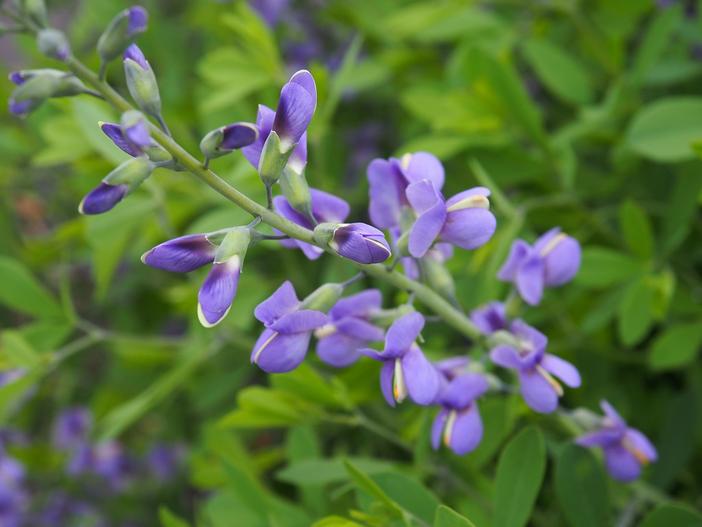Blue Wild Indigo
(Baptisia minor)
Blue Wild Indigo (Baptisia minor)
/
/

F. D. Richards
CC BY-SA 2.0
Image By:
F. D. Richards
Recorded By:
Copyright:
CC BY-SA 2.0
Copyright Notice:
Photo by: F. D. Richards | License Type: CC BY-SA 2.0 | License URL: https://creativecommons.org/licenses/by-sa/2.0/ | Uploader: F. D. Richards | Publisher: Flickr
























Estimated Native Range
Summary
Baptisia minor, commonly known as Blue Wild Indigo, is a deciduous perennial herb native to open woodlands, prairies, and glades in the Central and Southwestern USA. It typically grows to a height and width of 2-3 feet (0.6-0.9 meters), forming a compact, bushy mound. The plant features trifoliate (three-parted) leaves and produces upright spikes of pea-like, vivid blue to indigo flowers in late spring to early summer, which are highly attractive to pollinators. After flowering, it forms ornamental, inflated seed pods that turn charcoal black, adding interest to the garden in the fall.
Blue Wild Indigo is valued for its drought tolerance and low maintenance requirements, making it a suitable choice for xeriscaping and native plant gardens. Its deep root system helps it withstand dry conditions, and once established, it requires minimal care. It is often used in borders, meadow plantings, and as a specimen in naturalized areas. In terms of cultivation, it thrives in full sun to part shade and prefers well-drained soils, although it is adaptable to various soil types. While generally pest and disease-free, it can be susceptible to root rot in poorly drained soils.CC BY-SA 4.0
Blue Wild Indigo is valued for its drought tolerance and low maintenance requirements, making it a suitable choice for xeriscaping and native plant gardens. Its deep root system helps it withstand dry conditions, and once established, it requires minimal care. It is often used in borders, meadow plantings, and as a specimen in naturalized areas. In terms of cultivation, it thrives in full sun to part shade and prefers well-drained soils, although it is adaptable to various soil types. While generally pest and disease-free, it can be susceptible to root rot in poorly drained soils.CC BY-SA 4.0
Plant Description
- Plant Type: Herb
- Height: 1.5-2 feet
- Width: 1.5-2 feet
- Growth Rate: Moderate
- Flower Color: Purple
- Flowering Season: Spring, Summer
- Leaf Retention: Deciduous
Growth Requirements
- Sun: Full Sun, Part Shade
- Water: Low, Medium
- Drainage: Medium
Common Uses
Bee Garden, Bird Garden, Border Plant, Butterfly Garden, Deer Resistant, Drought Tolerant, Erosion Control, Groundcover, Low Maintenance, Rabbit Resistant, Salt Tolerant, Showy Flowers
Natural Habitat
Native to open woodlands, prairies, and glades in the Central and Southwestern USA
Other Names
Common Names: Blue False Indigo,
Scientific Names: , Baptisia minor, Baptisia australis var. minor, Baptisia vespertina, Baptisia versicolor, Baptisia minor var. australis, Baptisia texana,
GBIF Accepted Name: Baptisia australis var. minor (Lehm.) Fernald